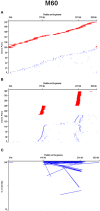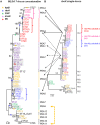Recombination Does Not Hinder Formation or Detection of Ecological Species of Synechococcus Inhabiting a Hot Spring Cyanobacterial Mat
- PMID: 26834710
- PMCID: PMC4712262
- DOI: 10.3389/fmicb.2015.01540
Recombination Does Not Hinder Formation or Detection of Ecological Species of Synechococcus Inhabiting a Hot Spring Cyanobacterial Mat
Abstract
Recent studies of bacterial speciation have claimed to support the biological species concept-that reduced recombination is required for bacterial populations to diverge into species. This conclusion has been reached from the discovery that ecologically distinct clades show lower rates of recombination than that which occurs among closest relatives. However, these previous studies did not attempt to determine whether the more-rapidly recombining close relatives within the clades studied may also have diversified ecologically, without benefit of sexual isolation. Here we have measured the impact of recombination on ecological diversification within and between two ecologically distinct clades (A and B') of Synechococcus in a hot spring microbial mat in Yellowstone National Park, using a cultivation-free, multi-locus approach. Bacterial artificial chromosome (BAC) libraries were constructed from mat samples collected at 60°C and 65°C. Analysis of multiple linked loci near Synechococcus 16S rRNA genes showed little evidence of recombination between the A and B' lineages, but a record of recombination was apparent within each lineage. Recombination and mutation rates within each lineage were of similar magnitude, but recombination had a somewhat greater impact on sequence diversity than mutation, as also seen in many other bacteria and archaea. Despite recombination within the A and B' lineages, there was evidence of ecological diversification within each lineage. The algorithm Ecotype Simulation identified sequence clusters consistent with ecologically distinct populations (ecotypes), and several hypothesized ecotypes were distinct in their habitat associations and in their adaptations to different microenvironments. We conclude that sexual isolation is more likely to follow ecological divergence than to precede it. Thus, an ecology-based model of speciation appears more appropriate than the biological species concept for bacterial and archaeal diversification.
Keywords: Ecotype Simulation; Synechococcus; cyanobacteria; ecotype; multi-locus sequence typing; population genetics; recombination; speciation.
Figures





Similar articles
-
The molecular dimension of microbial species: 1. Ecological distinctions among, and homogeneity within, putative ecotypes of Synechococcus inhabiting the cyanobacterial mat of Mushroom Spring, Yellowstone National Park.Front Microbiol. 2015 Jun 22;6:590. doi: 10.3389/fmicb.2015.00590. eCollection 2015. Front Microbiol. 2015. PMID: 26157420 Free PMC article.
-
Influence of molecular resolution on sequence-based discovery of ecological diversity among Synechococcus populations in an alkaline siliceous hot spring microbial mat.Appl Environ Microbiol. 2011 Feb;77(4):1359-67. doi: 10.1128/AEM.02032-10. Epub 2010 Dec 17. Appl Environ Microbiol. 2011. PMID: 21169433 Free PMC article.
-
Fine-scale distribution patterns of Synechococcus ecological diversity in microbial mats of Mushroom Spring, Yellowstone National Park.Appl Environ Microbiol. 2011 Nov;77(21):7689-97. doi: 10.1128/AEM.05927-11. Epub 2011 Sep 2. Appl Environ Microbiol. 2011. PMID: 21890675 Free PMC article.
-
Bacterial species and speciation.Syst Biol. 2001 Aug;50(4):513-24. doi: 10.1080/10635150118398. Syst Biol. 2001. PMID: 12116650 Review.
-
The origins of ecological diversity in prokaryotes.Curr Biol. 2008 Nov 11;18(21):R1024-34. doi: 10.1016/j.cub.2008.09.014. Curr Biol. 2008. PMID: 19000803 Review.
Cited by
-
Microcoleus (Cyanobacteria) form watershed-wide populations without strong gradients in population structure.Mol Ecol. 2022 Jan;31(1):86-103. doi: 10.1111/mec.16208. Epub 2021 Oct 21. Mol Ecol. 2022. PMID: 34608694 Free PMC article.
-
Adaptations to nitrogen availability drive ecological divergence of chemosynthetic symbionts.PLoS Genet. 2024 May 31;20(5):e1011295. doi: 10.1371/journal.pgen.1011295. eCollection 2024 May. PLoS Genet. 2024. PMID: 38820540 Free PMC article.
-
Genotyping and Multivariate Regression Trees Reveal Ecological Diversification within the Microcystis aeruginosa Complex along a Wide Environmental Gradient.Appl Environ Microbiol. 2022 Feb 8;88(3):e0147521. doi: 10.1128/AEM.01475-21. Epub 2021 Nov 24. Appl Environ Microbiol. 2022. PMID: 34818109 Free PMC article.
-
Genomic Inference of Recombination-Mediated Evolution in Xanthomonas euvesicatoria and X. perforans.Appl Environ Microbiol. 2018 Jun 18;84(13):e00136-18. doi: 10.1128/AEM.00136-18. Print 2018 Jul 1. Appl Environ Microbiol. 2018. PMID: 29678917 Free PMC article.
-
Rhometa: Population recombination rate estimation from metagenomic read datasets.PLoS Genet. 2023 Mar 27;19(3):e1010683. doi: 10.1371/journal.pgen.1010683. eCollection 2023 Mar. PLoS Genet. 2023. PMID: 36972309 Free PMC article.
References
-
- Allewalt J. P., Bateson M. M., Revsbech N. P., Slack K., Ward D. M. (2006). Effect of temperature and light on growth of and photosynthesis by Synechococcus isolates typical of those predominating in the octopus spring microbial mat community of Yellowstone National Park. Appl. Environ. Microb. 72, 544–550. 10.1128/AEM.72.1.544-550.2006 - DOI - PMC - PubMed
-
- Becraft E. D., Wood J. M., Rusch D. B., Kühl M., Jensen S. I., Bryant D. A., et al. . (2015). The molecular dimension of microbial species: 1. Ecological distinctions among, and homogeneity within, putative ecotypes of Synechococcus inhabiting the cyanobacterial mat of Mushroom Spring, Yellowstone National Park. Front. Microbiol. 6:590. 10.3389/fmicb.2015.00590 - DOI - PMC - PubMed
LinkOut - more resources
Full Text Sources
Other Literature Sources
Molecular Biology Databases

